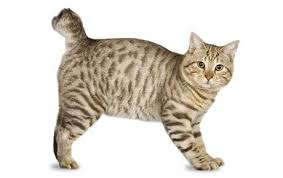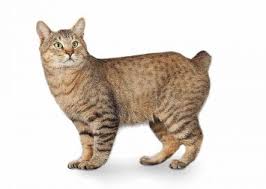John K. Rosembert
 The American Bobtail is an uncommon breed of domestic cat which was developed in the late 1960s, which descends from a short-tailed kitten acquired by a couple John and Brenda Sanders during a vacation to Arizona. It is a medium to large, semi-cobby cat. Their sturdy bone structure and well-developed musculature, along with their broad chest and slightly arched back (due to longer hind than front legs), give them the appearance of a small Lynx. Their head is broad with prominent cheeks and a strong chin, and a triangular-shaped muzzle a little wider than it is long. Their eyes are big and slightly almond-shaped. Their ears, which are average sized and sit quite low on the skull, each have a small tuft of fur at the end known as “Lynx tips”. The variety with mid-length fur also have tufts of fur between the toes.
The American Bobtail is an uncommon breed of domestic cat which was developed in the late 1960s, which descends from a short-tailed kitten acquired by a couple John and Brenda Sanders during a vacation to Arizona. It is a medium to large, semi-cobby cat. Their sturdy bone structure and well-developed musculature, along with their broad chest and slightly arched back (due to longer hind than front legs), give them the appearance of a small Lynx. Their head is broad with prominent cheeks and a strong chin, and a triangular-shaped muzzle a little wider than it is long. Their eyes are big and slightly almond-shaped. Their ears, which are average sized and sit quite low on the skull, each have a small tuft of fur at the end known as “Lynx tips”. The variety with mid-length fur also have tufts of fur between the toes.
The American Bobtail is devoted to family, and is very easily trained to walk on a leash. This cat breed enjoys playing with interactive cat toys, other cats, and children. The American Bobtail makes for an ideal family companion. This is a smart cat who enjoys puzzle toys, learning tricks, and playing fetch. He isn’t as vocal as some breeds, but he communicates his pleasure with chirps, clicks and trills, as well as the standard purr and meow.
The American Bobtail has an adaptable nature, so he’s a good traveler. Long-distance truckers and travelers find him to be an excellent companion. The cats have also found a niche with some psychotherapists because of their loving and intuitive nature. That same adaptability and kindness makes him a good family companion and suited to a variety of lifestyles, from relaxed to rowdy.
American Bobtails are generally healthy cats with no predispositions to inherited health conditions, however that doesn’t mean that every American Bobtail will never experience health problems, it’s important to note: American Bobtails with no tail may experience:
- Spinal Problems: The American Bobtail may be prone to spinal problem due to their short spine.
- Polycystic kidney disease (PKD): A condition characterized by the development of cysts on one or both kidneys.
- Hypertrophic cardiomyopathy: Which is the thickening of the heart muscle.
- Hip Dysplasia: This is rare in domestic cats, and is common in purebred cats. This occurs when the hip joint is loose, and leads to degenerative joint disease. (osteoarthritis) Symptoms include lameness that can be mild to severe. Cats generally need no surgery for hip dysplasia. Weight reduction can help reduce discomfort.
Source:
https://petonbed.com/american-bobtail/
https://www.thesprucepets.com/american-bobtail-full-profile-history-and-care-4705973
Photo credit: https://cattime.com/cat-breeds/american-bobtail-cats



